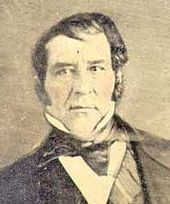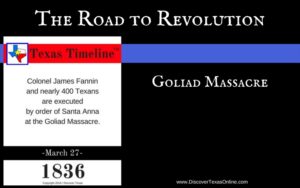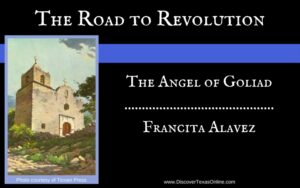Haden Edwards was one of the first Texas empresarios. His father was a senator who made his fortune in land. Haden studied law, but he, too, was more interested in land speculation. When he heard of Moses Austin’s plan to colonize Texas, Edwards traveled to Mexico City himself. In 1823 he joined Stephen F. Austin and others who were attempting to persuade the Mexican government to authorize Anglo immigration. Because Edwards was a wealthy man, Austin sometimes depended upon his finances. Though they finally succeeded in getting permission in 1825, Edwards felt slighted. He believed Austin claimed the best land for himself and accused him of pushing his boundary lines. As this defensive attitude resurfaced on many occasions in Edwards’ life, he caused himself no end of trouble.
Edwards moved his wife and 13 children to his grant in the vicinity of Nacogdoches where he had permission to settle 800 families (compared to Austin’s 300).
Since the land grants were very large with boundaries rather generally described, it was the policy to ask all empresarios to agree to honor any preexisting grants and claims made by Spain or Mexico that might be included within their boundaries. The Edwards claim was in an area of Texas colonists had been trying to settle for years, even centuries. His solution was to post notices informing existing claim owners to come forward and prove their claims. If they could not provide written proof, he would consider the land his to be sold to newcomers. This made the older settlers understandably angry and was an important issue in an election between their representative, Samuel Norris, and Edwards’s son-in-law, Chichester Chaplin, for the office of alcalde. As empresario, Edwards certified the election results and proclaimed his son-in-law the winner. Samuel Norris protested the election results to Governor Saucedo in San Antonio. Saucedo upheld Norris’s claim that he had won and ordered any records and tax money to be turned over to Norris, but Chaplin refused to step down. Norris called for back-up from the local militia. So many settlers complained that Edwards came under suspicion, and his brother Benjamin fired off a letter to government officials in his defense…but his efforts backfired. The Mexican government revoked the Edwards grant.
Edwards was shocked and greatly dismayed. He had invested over $50,000 in his grant. If he walked away, he would lose all of his investment, and any claims he had sold to settlers would be forfeited as well. He may have wondered what would happen if they all demanded their money back, but the new settlers sided with Edwards, who determined not to surrender without a fight. He and his brother declared their grant an independent republic. They called their new “nation” Fredonia, and began to design a flag and raise an army, but when they came under actual threat of arms, the settlers scattered. Edwards fled to Louisiana for safety. During the Texas Revolution in 1836 he returned, settling again in Nacogdoches, where he remained until his death on 14 August 1849.
The Edwards Plateau and Edwards County, Texas are named for him.




